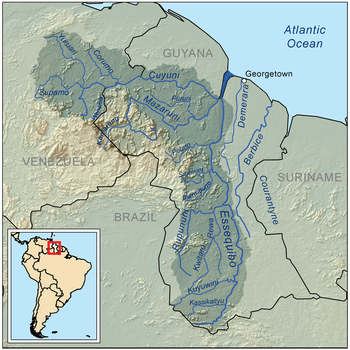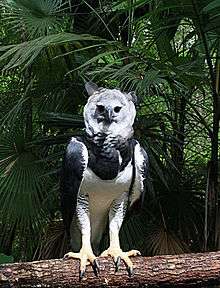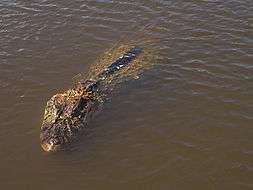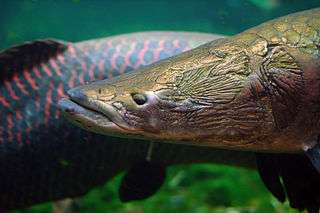Rupununi
The Rupununi is a region located in the South-West of Guyana, bordering the Brazilian Amazon. The Rupununi river, also known by the local indigenous peoples as Raponani, flows through the Rupununi region. The name "Rupununi" originates from the Makushi (a dialect of one of the communities) word rapon, which is a black-bellied whistling duck (Dendrocygna autumnalis) found along the river.[1]

Geography
The Rupununi River is one of the main tributaries of the Essequibo River and is located in southern Guyana. The river originates in the Kanuku Mountains, which are located in the Upper Takutu-Essequibo region. The Rupununi River flows near the Guyana-Brazil border, and eventually leads into the Essequibo River. Throughout the flood season, the river shares a watershed with the Amazon. During the rainy season it is connected to the Takutu River by the flooded Pirara Creek, draining the vast swamps of the Parima or Amaku Lake. The region surrounding the Rupununi river is composed of mainly savannah, wetlands, forest, and low mountain ranges.
Animal Life
The areas both in and surrounding the Rupununi river are home to a great diversity of terrestrial and aquatic ecosystems that harbor many species extirpated from other areas of South America. The Rupununi's freshwater eco-regions are areas of exceptional species richness, comparable to that of the Amazonia.[1] Flora and fauna flourish in the Rupununi river because of the Rupununi's isolation from human activity. During an expedition, the South Rupununi Biodiversity Assessment Team (BAT), described the Rupununi river as being "very diverse".[2]"The Northern Rupununi has more than fourteen hundred species of vertebrates, more than twenty-eight hundred species of plants, and countless species of invertebrates" (Rupununi, Rediscovering a Lost World).[1]
Birds

The vegetation and unperturbed tree life along the Rupununi river, is a haven for rare species of bird-life. A biodiversity study conducted by BAT (South Rupununi Biodiversity Assessment Team), discovered a total of 306 bird species living along the river.[3] The critically endangered Red Siskin (Carduelis cucullata), was one of the many species of bird that were re-discovered in the Rupununi river. Another avian-survey of the North Rupununi river, conducted by David C. Morimoto, Gajendra Nauth Narine, Michael D. Schindlinger and Asaph Wilson (DCM, MDS), showed that "4243 individuals, 292 species, and 58 families"[4] of birds inhabited the Northern Rupununi river. Other rare bird species that were found in the survey were the Crested Doradito (Pseudocolopteryx sclateri) and the Sun Parakeet (Aratinga solstitialis).[4] The famed Harpy Eagle also inhabits the Rupununi and is the largest aerial predator in South America.[1]
Notable species include:
- Harpy Eagle (Harpia harpyja)
- Red Siskin (Carduelis cucullata)
- Vampire Bat (Vampyrum spectrum)
- Rufescent Tiger-Heron [5](Tigrisoma lineatum)
- Wattled Jacanas[5] (Jacana jacana)
Reptiles

Reptiles thrive in the Rupununi river, preying off of small fish and crustaceans. In another study conducted by the BAT (South Rupununi Biodiversity Assessment Team), it was discovered that 34 different species[3] of reptiles were living along the river. The black caiman is the largest predator in the Rupununi, measuring up to 5 meters in length, however it has become endangered due to hunting for their belly skins throughout the 1930s - 1970s.[1]
Notable species include:
- Black caiman[3] (Melanosuchus niger)
- Emerald tree boa[3] (Corallus caninus)
- Green anaconda[3] (Eunectes murinus)
- Red-footed tortoise[3] (Chelonoidis carbonaria)
- Neotropical rattlesnake[3] (Crotalus durissus)
- Giant River Turtle (Podocnemis expansa)
Large Mammals

The Rupununi is home to relatively healthy populations of the South America's giant mammals, including the largest feline terrestrial predators, the jaguar (Panthera onca) and the puma (Puma concolor).[1] Both the jaguar and the puma are extremely elusive cats, adept at hunting anything from turtles to domesticated dogs.[1] However they are seen as threats to livestock, and are hunted, which has ultimately resulted in a decline in their population numbers. Another large mammal that lives in the Rupununi is the Giant otter (Pteronura brasiliensis), which is the largest otter in the world. Various species of apes and smaller terrestrial herbivores and insectivores such as the Tapir (Tapirus), also live and forage along the Rupununi river.
Notable species include:
- Jaguar (Panthera onca)
- Puma (Puma concolor)
- Giant Otter (Pteronura brasiliensis)
- Howler monkeys (Alouatta)
- Capybara (Hydrochoerus hydrochaeris)
- Giant Anteater (Myrmecophaga tridactyla)
Aquatic Life

The Rupununi has one of the most diverse aquatic ecosystems on the planet. A total of 410 species of fish inhabit the Rupununi, surpassing that of French Guiana (298 species) and Suriname (309 species).[1] However since there is a lack of freshwater fish taxonomists and researchers studying the area, it is estimated that there are at least 600 different species of fish in the Rupununi.[1] Giants also lurk in the waters of the Rupununi. The arapaima (Arapaima) and the Lau-Lau (B. filamentosum) each measuring approximately 2, and in some exceptional cases 4 meters in length,[6] have been found in the most remote corners of the Rupununi river. However, these river monsters are seldom seen and are rarely ever caught. Overexploitation and overfishing have forced these two species of fish to migrate deeper into unexplored territory in the Rupununi.[7]
Notable species include:
- Arapaima (Arapaima)
- Lau-Lau (B. filamentosum)
- Red-Bellied Piranha (Pygocentrus nattereri)
- Lukanani, Butterfly Peacock Bass (Cichla ocellaris)
- Redtail Catfish (Phractocephalus hemioliopterus)
History
Precolonial Civilization

Indigenous peoples have been part of the Rupununi landscape for millennia. Anthropologists have discovered Paleo-Indian petroglyphs, dated to be several thousands of years old[1] along the course of the Rupununi river. Before the colonization of Guyana and the Rupununi region, the Makushi Amerindians, Wai-Wai and the Wapishana all inhabited the area. The Makushi migrated from what is now known as modern Brazil and Venezuela, to the northern areas of the Rupununi river, over four-hundred years ago.[1] The Makushi Amerindians continue to live in the Rio Branco savannahs and northern Rupununi, surviving off of the abundance of fish, wildlife and forest resources of the area.
Age of Exploration
Sir Walter Raleigh claimed that the Rupununi was where the famed El Dorado was situated, however he never explored the river. Other early explorers such as Charles Waterton and Robert Schomburgk attempted to locate El Dorado, and successfully managed to visit the supposed location of the South-American myth, which is in fact part of the northern Rupununi. However they never found El Dorado.
20th Century Development
Guyana is a developing country that lacks sustainable economic, environmental and investment growth. Exploiting the Rupununi's resources through corporate agriculture, mining and petroleum extraction are potential pathways that Guyana could undertake. Extant roads such as the one connecting the Rupununi and the state of Roraima are being upgraded to travel all the way to Georgetown. A bridge has also been constructed on the Guyana-Brazil border, that links Lethem (Guyana) to Bonfim (Brazil). This infrastructure will facilitate the transportation of goods throughout the area, however it poses a threat to the Rupununi's fragile eco-system.
In order to formally protect the Rupununi's eco-system, NGO's and the Guyanese government have partnered up to attempt to enforce legislation to ban any perjudicial human activity towards the environment and wildlife in the Rupununi.[1]
Eco-tourism
Eco-tourism in the Rupununi is an important part of Guyana's economy. There are many ranches and lodges such as the Karanambu Ranch, a protected area for giant otters and other endangered species in the Rupununi, started by Tiny McTurk (1927),[8] that generate revenue from tourists visiting the Rupununi.
See also
- Rappu Falls
- Essequibo River
- Guyana Rivers
- Rupununi Savannah
- Amazon
References
- 1 2 3 4 5 6 7 8 9 10 11 12 Rupununi Rediscovering a Lost World. China: Earth In Focus. 2010. p. 5. ISBN 978-0-9841686-4-4.
- ↑ GuyanaTimes. "Study team finds high level of biodiversity in Rupununi". Guyana Times. Retrieved 2016-02-19.
- 1 2 3 4 5 6 7 Global Wildlife Conservation (December 2013). "SOUTH RUPUNUNI BIODIVERSITY ASSESSMENT TEAM (BAT) EXPEDITION" (PDF). Biodiversity in the Rupununi.
|first1=missing|last1=in Authors list (help) - 1 2 David C. Morimoto, Gajendra Nauth (Andy) Narine, Michael D.schindlinger & Asaph Wilson. "A Baseline Avian Survey of the North Rupununi River, Region 9, Guyana." A Baseline Avian Survey of the North Rupununi River, Region 9, Guyana (n.d.): n. pag. Web. 19 Feb. 2016. <http://www.ao.com.br/download/AO183_33.pdf>.
- 1 2 "DAGRON TOURS | Bird Watching | Guyana Birds: Bonanza". www.dagron-tours.com. Retrieved 2016-02-19.
- ↑ "Brachyplatystoma filamentosum summary page". FishBase. Retrieved 2016-02-21.
- ↑ "BBC Nature - Giant Amazon fish 'locally extinct' due to overfishing". 2014-08-14. Archived from the original on August 14, 2014. Retrieved 2016-02-21.
- ↑ Productions, Biograph II. "The Karanambu Trust & Eco-tourist Lodge". www.karanambutrustandlodge.org. Retrieved 2016-02-21.
- Vegamián, Félix María de (Father, Order of Friars Minor Capuchin). El Esequivo, frontera de Venezuela. Documentos históricos y experiencias personales. Madrid: Talleres Tipográficos Raycar S. A., 1968.
External links
| Wikimedia Commons has media related to Rupununi. |
